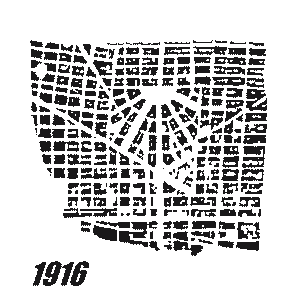About a week ago, Google celebrated Mies van der Rohe's 126th birthday with a doodle of his 1956 project, Crown Hall, at the Illinois Institue of Technology in Chicago. The doodle came complete with four box girders, their eight supporting columns, and 'Google' cleanly spelled across the facade (The letters with appropriate levels of transparency, according to their clear or frosted glass hosts, were a nice touch). So I wanted to take a minute to write a bit about Mies' Lafayette Park project in Detroit.
I had the pleasure of sitting in on a lecture in January at the Yale School of Architecture by Charles Waldheim, Chair of Landscape Architecture at Harvard. Waldheim is often credited with coining the term Landscape Urbanism, or the use of landscape and the organization of horizontal elements, rather than buildings, as the driver of urban form. I tend to recoil from the thought of sprawling landscapes as an organizer of city form, while visions of lifeless, drab suburbs flash in front of my eyes. I usually find myself gravitating towards dense cityscapes, vibrant neighborhoods and tree lined streets, pockets of the city carved out as park space. I am of the mind that urban spaces should be urban and rural spaces should be rural, both valuable to each other, yet independent. The space in between the two tends to struggle for identity.
Lafayette Park is certainly more park than urbanism, yet I find myself drawn to its serene configuration. The project was the first urban renewal project in the US, and remains arguably the most successful, despite Detroit's present condition. Mies is often credited with the project, probably because his is the most famous name of the group, but the project's success is a direct result of a triumphant collaboration between architect (Mies), planner (Ludwig Hilbersheimer), landscape architect (Alfred Caldwell), developer (Herbert Greenwald) and city. Lafayette Park is the largest collection of Mies buildings in the world, but it would not have succeeded had all the valuable pieces not performed their roles so well.
Hilbersheimer demanded that the project be available to residents of every social and economic situation. Caldwell brought a sophisticated ecological infrastructure, and Mies designed refined yet affordable buildings. While it is no secret that Mies was a tireless self promoter and the number one starchitect of his day, his clean and efficient buildings often cost less per square foot than many of his contemporaries. Lafayette Park is a shining example of that ability.
 |
| Courtesy: Michigan Modern |
The city of Detroit has been slowly decaying since the first half of the 20th century, this project was an effort to curb the trend of flight to the suburbs that Detroit, along with so many other cities, experienced in post-war America. The site of the project was formerly known as 'Black Bottom' section of Detroit, named for rich soil deposits brought by flooding in the early years of the city. The neighborhood's residents were displaced and the buildings demolished, sitting empty for years, while the city haggled and argued over what to do with the site before bringing in the team of Greenwald, Mies, Hilbersheimer and Caldwell.

Greewald declared when the project started that "this city is damned, but by no means doomed". He envisioned a community within a city where the residents could live, work, shop and play. The program included dwelling units, office space, shopping and a public school. Greenwald knew that the project would not be able to house enough permanent residents to support the retail that was required, so all of the large commercial blocks were located at the periphery of the site, creating a porous boundary to the park that could be accessed by both insiders and outsiders.
In his lecture, Waldheim drew some fascinating parallels between the abandonment of 20th Century Detroit and the abandonment of ancient Rome, and how the later played a crucial role in the development of the type of landscape urbanism that makes the former such a success.
Rome sat as an empty shell of its former self inside its Aurelian walls for nearly a millenium, making present day Detroit look like Paris. In the sixth century, the population of Rome dropped from over one million to less than 30,000 people due to warfare, famine, and social unrest. The population of Detroit has dropped from over 1.8 million at its peak in 1950, to under 900,000 in 2009.
The Ruins of Detroit is the website that immediately came to mind during the lecture.
He tied in the notion of urban landscape's origin as a theatrical backdrop founded in 14th Century theater and art where landscape was used as a way of seeing the world. How modern landscape is a product of emotional loss, the loss of a tie with man's foundational natural surroundings. He also highlighted Claude Lorrain's paintings of the small pieces of the disabitato that remained in the 16th century. His landscapes were so attractive because they depicted not what is rural, but what was once urban, which is fascinating to me.
Lafayette park, while not a pure urbanism, is certainly not suburban or rural. It is a unique project that broke a lot of rules and succeeded. Members of the development team made demands that were adhered to - mixing of social classes, richly functioning ecological systems, world class architecture - and the project is an overwhelming success by any measure. A superb example of urban renewal that can work. Certainly not what comes to mind when I think of what downtown blocks of major cities should be, but a fantastic project.
Present day Detroit is often referred to as a blank cavas for architects and city planners. Lafayette Park certainly shows one way to paint the Image of the City.
For more images and testimonials of Lafayette Park, here is a New York Times interactive feature and a slideshow from Dwell.












.jpg)

